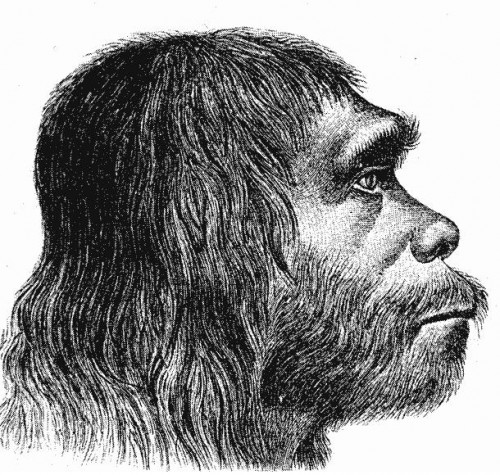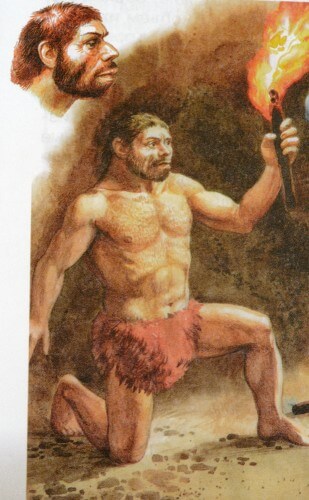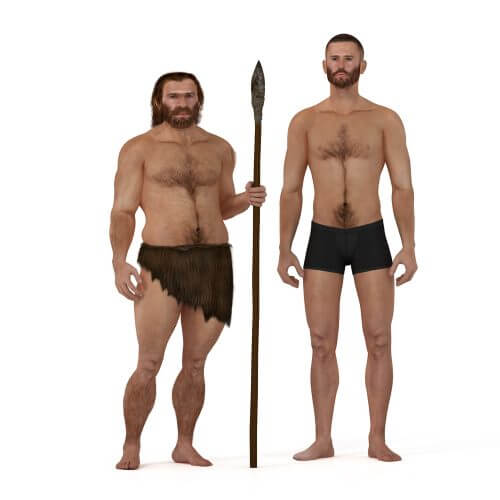Since the discovery of the remains of the Neanderthals (Homo neanderthalensis), many researchers have been busy examining the genetic, physiological and mental differences between them and modern man, and even researching the customs, rituals and lifestyle of the Neanderthals. This topic is particularly interesting in light of the fact that for a long period of about 270,000 years the two species lived at the same time

Written by: Roi Yaniv, (Grammatical edit: Dafna Lev)
Joachim Neander, a clergyman, teacher and Christian poet from the 17th century (whose grandfather changed his German name "Neumann" to its Greek version "Neander", as was customary at the time),[1] He did not know that the name of the valley near Dusseldorf in Germany, where he used to sit and from which he drew inspiration for writing his religious hymns, would be changed and named after him, to honor his memory after his death. It is possible that he and the namesakes of the valley would have preferred his name to be remembered thanks to his hymns, which were considered miraculous works even in his lifetime, but fate had its way and in the middle of the 19th century his name began to be mentioned by everyone when human remains were discovered in the Neander Valley. After a careful examination, the remains were classified as a separate species in the genus "Homo", which until that time had one and only representative - the modern man, Homo sapiens.
Since the discovery of Neanderthal remains (Homo neanderthalensis), many researchers are busy examining the genetic, physiological and mental differences between them and modern man, and even research the customs, rituals and lifestyle of the Neanderthals. This topic is particularly interesting in light of the fact that, for a long period of about 270,000 years, the two species lived at the same time: the Neanderthals apparently lived from 400,000 years ago to about 30,000 years ago, and Homo sapiens from about 300,000 years ago to the present day. Over the years, the remains of additional hominins have been discovered, whose honor rests in their place, but for now the Neanderthal is considered the closest hominin to modern man chronologically.
One of the most interesting questions, which still cannot be answered unequivocally, is the reason for the disappearance of the Neanderthals. According to fossil evidence, about 40,000 years ago[2] A downward trend began in the Neanderthal populations, which gradually dwindled until they became completely extinct. Many hypotheses have been put forward to explain their extinction: climate change, violence, disease, natural disasters, assimilation into modern human populations, failure to compete with modern man, and more. Most of the hypotheses can stand side by side and constitute cumulative factors, which resulted in great evolutionary pressure. Frequent extreme climate changes could have been too much of a hardship for the Neanderthals. Not only because of problematic weather, as based on their relatively low height and structure
Their stout and broad bodies suggest that they were adapted to cold climates[3] (facts that correspond to Clal Bergman) and that they knew how to make tools and fire,[4] However, far-reaching environmental changes may have occurred, which resulted in a significant depletion of resources in the ecological niche, which in the past suited their needs.[5]
But if the climate changed, why didn't the Neanderthals migrate south? There could be many reasons for this as well. One of the explanations is that they met populations of other hominins, which constituted a physical obstacle for them, which leads us to another hypothesis for their extinction: an encounter with Homo sapiens, which came out of Africa and settled the rest of the world.
Competition for resources can cause many conflicts between populations that are geographically close to each other, and the immediate solution is likely to be violence. Even in more modern times, human history is full of wars, especially when one side feels superior to the other. It is possible that despite the relative physical robustness of the Neanderthals, modern man enjoyed cognitive (for which there is currently no evidence) and physical advantages, such as throwing javelins and stones over long distances, fast and prolonged running, and advanced language skills. These advantages may have been reflected in repeated encounters between the two species that lived in the same ecological niche.[6]

The cognitive function of Neanderthals was apparently not the same as that of modern man. However, it seems that they were no less intelligent than the modern man, and there is no doubt that if the name proposed by the researcher Ernst Heckel was accepted - Homo stupidus - We would be doing them a great injustice. It seems that the cognitive differences between the two sexes are rooted in different areas of the brain, which were developed differently.[7]
Another competitive advantage of the modern man may have resulted from his tendency to live in relatively large and less isolated communities, which allowed a division of labor and a more efficient use of the environmental resources.[8]
Prof. Yoel Rak's lectures ("The Evidence of Fossils for the Evolution of Man"),[9] shed light on other interesting differences - differences in the bones of the skull and bones of the pelvis - which indicate significant differences in the lifestyle of the two sexes. Unlike modern man, who grinds food with the teeth in the back of the mouth, Neanderthals ground their food with the front teeth. This is a departure from the primitive skull structure of other hominins, including modern man. This structure may have been an advantage in the living conditions that prevailed in certain periods, but it became a disadvantage when the Neanderthals had to adapt to changes in their living environment. Compared to the jaw, the Neanderthal pelvis is a primitive pelvis, which is not effective in prolonged walking and running compared to the modern man's pelvis. If there was indeed a decrease in the availability of resources (a decrease in the availability of vegetation, resulting in a depletion of large animal species, which they fed on), the Neanderthals would not have been able to subsist on alternative food, because they could not keep up with the pace required to hunt other animals. The ability to run long distances is invaluable when adapting to a new type of prey, and Neanderthals did not adapt to this practice.[10]

Physical proximity between the two species can also result in the transmission of pathogens and parasites, which is another possible reason for the extinction of the Neanderthals. On the other hand, there is also the possibility that they themselves served as harbors of diseases, which could have infected modern man.[11]
Another theory, which gained momentum with the development of the ability to test the Neanderthal genome, is the assimilation of the Neanderthals into Homo sapiens populations as a result of breeding between the two species. Genetic testing indicates a small percentage of Neanderthal genomes in modern humans of European and Asian descent.[12] However, cases of interbreeding may have occurred only in the distant past, when the ancestor of Homo sapiens came into contact with Neanderthals,[13] Because it seems that encounters with Homo sapiens were relatively rare[14] And the physical and cognitive differences between them contradict this idea.
Natural disasters are also included in the list of causes of extinction. The eruption of a volcano in Naples, Italy, about 40,000 years ago, has been suggested as one of the reasons that contributed to the extinction of the Neanderthals.[15]
And finally, there is also a more neutral model, which holds that the continuous migration of Homo sapiens from Africa to the rest of the world led to an inevitable decline in the Neanderthal population, whose individuals were fewer in number, and that no additional factors are needed to explain their extinction.[16]
Research on the subject continues, but it is likely that a combination of several factors led to the extinction of those who were a major part of the puzzle of modern human evolution. It is also possible that new hypotheses will be raised about the causes of the extinction. The hope is that constant and ongoing research will shed more light on the subject.
More of the topic in Hayadan:
- DNA tests made it possible to discover a mixture of Neanderthals and Denisovans
- Modern man has lost genes that were on the Y chromosome of the Neanderthals
- Humans did not develop from one source, but survived from a variety of populations that intermingled
Sources
[1] Thissen, S. 2000. Neanderthal: die Geschichte geht weiter. Heidelberg: Spektrum Akademischer Verlag.
[2] Higham, T., K. Douka, R. Wood, CB Ramsey, F. Brock, L. Basell, M. Camps, A. Arrizabalaga, J. Baena, C. Barroso-Ruíz, C. Bergman, C. Boitard, P. Boscato, M. Caparrós, NJ Conard, C. Draily, A. Froment, B. Galván, P. Gambassini, A. Garcia-Moreno, S. Grimaldi, P. Haesaerts, B. Holt, M.-J. Iriarte-Chiapusso, A. Jelinek, JF Jordá Pardo, J.-M. Maíllo-Fernández, A. Marom, J. Maroto, M. Menéndez, L. Metz, E. Morin, A. Moroni, F. Negrino, E. Panagopoulou, M. Peresani, S. Pirson, M. de la Rasilla, J. Riel-Salvatore, A. Ronchitelli, D. Santamaria, P. Semal, L. Slimak, J. Soler, N. Soler, A. Villaluenga, R. Pinhasi & R. Jacobi (2014) The timing and spatiotemporal patterning of Neanderthal disappearance. Nature, 512, 306.
[3] Weaver, TD (2009) The meaning of Neandertal skeletal morphology. Proceedings of the National Academy of Sciences, 106, 16028.
[4] Sorensen, AC, E. Claud & M. Soressi (2018) Neandertal fire-making technology inferred from microwear analysis. Scientific Reports, 8, 10065.
[5] Finlayson, C. & JS Carrión (2007) Rapid ecological turnover and its impact on Neanderthal and other human populations. Trends in Ecology & Evolution, 22, 213-222.
[6] Banks, WE, F. d'Errico, AT Peterson, M. Kageyama, A. Sima & M.-F. Sánchez-Goñi (2008) Neanderthal Extinction by Competitive Exclusion. PLoS One, 3, e3972.
[7] Kochiyama, T., N. Ogihara, HC Tanabe, O. Kondo, H. Amano, K. Hasegawa, H. Suzuki, MS Ponce de León, CPE Zollikofer, M. Bastir, C. Stringer, N. Sadato & T . Akazawa (2018) Reconstructing the Neanderthal brain using computational anatomy. Scientific Reports, 8, 6296.
[8] Kuhn, Steven L. & Mary C. Stiner (2006) What's a Mother to Do? The Division of Labor among Neandertals and Modern Humans in Eurasia. Current Anthropology, 47, 953-981.
[9] https://www.youtube.com/playlist?list=PLNiWLB_wsOg4_NFxwl7Zyx-wVDfupbk_e
[10] Raichlen, DA, H. Armstrong & DE Lieberman (2011) Calcaneus length determines running economy: Implications for endurance running performance in modern humans and Neandertals. Journal of Human Evolution, 60, 299-308.
[11] Houldcroft, CJ & SJ Underdown (2016) Neanderthal genomics suggests a pleistocene time frame for the first epidemiologic transition. American Journal of Physical Anthropology, 160, 379-388.
[12] Green, RE, J. Krause, AW Briggs, T. Maricic, U. Stenzel, M. Kircher, N. Patterson, H. Li, W. Zhai, MH-Y. Fritz, NF Hansen, EY Durand, A.-S. Malaspinas, JD Jensen, T. Marques-Bonet, C. Alkan, K. Prüfer, M. Meyer, HA Burbano, JM Good, R. Schultz, A. Aximu-Petri, A. Butthof, B. Höber, B. Höffner , M. Siegemund, A. Weihmann, C. Nusbaum, ES Lander, C. Russ, N. Novod, J. Affourtit, M. Egholm, C. Verna, P. Rudan, D. Brajkovic, Ž. Kucan, I. Gušic, VB Doronichev, LV Golovanova, C. Lalueza-Fox, M. de la Rasilla, J. Fortea, A. Rosas, RW Schmitz, PLF Johnson, EE Eichler, D. Falush, E. Birney, JC Mullikin, M. Slatkin, R. Nielsen, J. Kelso, M. Lachmann, D. Reich & S. Pääbo (2010) A Draft Sequence of the Neandertal Genome. Science, 328, 710.
[13] Kuhlwilm, M., I. Gronau, MJ Hubisz, C. de Filippo, J. Prado-Martinez, M. Kircher, Q. Fu, HA Burbano, C. Lalueza-Fox, M. de la Rasilla, A. Rosas, P. Rudan, D. Brajkovic, Ž. Kucan, I. Gušic, T. Marques-Bonet, AM Andrés, B. Viola, S. Pääbo, M. Meyer, A. Siepel & S. Castellano (2016) Ancient gene flow from early modern humans into Eastern Neanderthals. Nature, 530, 429-433.
[14] Currat, M. & L. Excoffier (2011) Strong reproductive isolation between humans and Neanderthals inferred from observed patterns of introgression. Proceedings of the National Academy of Sciences, 108, 15129.
[15] Golovanova, LV, VB Doronichev, NE Cleghorn, MA Koulkova, TV Sapelko & MS Shackley (2010) Significance of Ecological Factors in the Middle to Upper Paleolithic Transition. Current Anthropology, 51, 655-691.
[16] Kolodny, O. & MW Feldman (2017) A parsimonious neutral model suggests Neanderthal replacement was determined by migration and random species drift. Nature Communications, 8, 1040.

9 תגובות
bullshit. Are you bored? You are just fooling people just to make them believe you.
Very good and professional article
No need to look for additional benefits.
The obsessive xenophobia of modern man is enough to give him enough motivation to eliminate groups of the opposite sex at every opportunity.
Thanks for the article, beautifully written and informative! I saw that you mentioned the points, but I would add a little more about the social/communicative difference that probably existed between them. A difference that resulted from the different morphology of the skull and the preferred prefrontal of Sapiens + reference to the morphology of the hyoid bone and its consequences, etc. + As a result, "social brain" theories of Sapiens, a high number of Dunbar, superior language and communication that probably also influenced different hunting methods that were mainly an advantage during the last ice age (and its ecological consequences) that characterized the end of the Pleistocene.
Thanks for the article, beautifully written and informative! I saw that you mentioned the points, but I would add and give a little more weight to the social/communication difference that probably existed between them and had a lot of influence - a difference that resulted from the different morphology of the skull and the preferred prefrontal of Sapiens + reference to the morphology of the hyoid bone and its consequences, etc. + As a result, "brain" theories "Social" by Sapiens, a high Dunbar number, language and priority communication that influenced many channels. Including, various hunting methods that were an advantage mainly during the last ice age (and its ecological consequences) that characterized the end of the Pleistocene.
An inventory of 2-3% of Neanderthal DNA in the population of Europe and Asia is not negligible at all, and there were probably many family ties between us and them. It is clear that according to the usual definition of biological species we are the same species, with minor differences. It is not clear to me from where the author is that there are significant cognitive differences - it is possible that the only cognitive difference is a tendency to live in larger groups.
In a few hundred years they will make an article about the extinction of the whites
Hallelujah and one day there will be a Neanderthal clone. Unusually intriguing.
Well done for the references. A fascinating article must have references and many times translators tend to give them up. An article with so many documented references gives the reader a lot of confidence, even if he is not going to check them